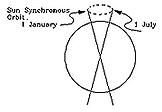Sun-synchronous Orbits
The Earth is not an exact sphere but bulges slightly at its equator. Any orbit passing exactly above the geographic poles is symmetrically affected by the bulge and its plane stays fixed relative to the stars.
The orbital plane of a satellite in space is best defined by its perpendicular direction (its "normal"), defined by distant stars, whose direction on the celestial sphere is fixed. Because Earth orbits the Sun, the angle between the Sun's direction and the orbit's normal slowly changes, increasing by 360° in the course of each year. (The closed path annually taken by the Sun among the stars is known as the ecliptic, and 12 constellations along it, named by the ancients, form the zodiac.) If the normal to the orbit of the polar satellite points at the Sun now, three months from now the Sun's motion across the sky will make the normal perpendicular to the Sun's direction.

An inclined orbit, whose northermost point is not the north pole but falls short by (say) 1000 km, will be affected asymmetrically by the Earth's bulge, and as a result its orbital plane would slowly rotate around the Earth's axis. With a suitable inclination, about 8 degrees off the polar orbit, that motion matches the slow motion of the Sun across the sky. If the satellite then starts near a noon-midnight orbit, it will always pass near noon and near midnight. A noon-midnight "Sun-synchronous" orbit was actually used by some DMSP satellites.
A different choice was made for MAGSAT, orbited 1979-80 to survey the
Earth's own magnetic field near its surface. Magnetic fields from the
magnetosphere are a disturbing factor in such a mission, a factor that strongly depends on the orientation of the orbit relative to the Sun's direction. By placing the
satellite in a sun-synchronous orbit near the dawn-dusk plane (90 degrees to the
noon-midnight plane described earlier), not only was the interference kept small, but because the orbit's orientation relative to the Sun did not change, the disturbance also stayed more or less the same throughout the mission.
On the other hand, the Dynamics Explorer (DE) mission of 1981 used two polar
spacecraft, one in a low orbit to intercept the aurora (among other things) and
a second one in an elongated orbit to observe auroral acceleration and also to
take pictures of the entire auroral oval from a distance. To ensure the best
chance for the two spacecraft to intercept the same auroral electron beam at
different altitudes, it was decided that both orbits would always share the same plane. They were therefore made to pass over the geographical poles: with
any other choice the Earth's bulge would have rotated the planes at different
rates and they would have soon drifted apart.
Questions from Users:
***
